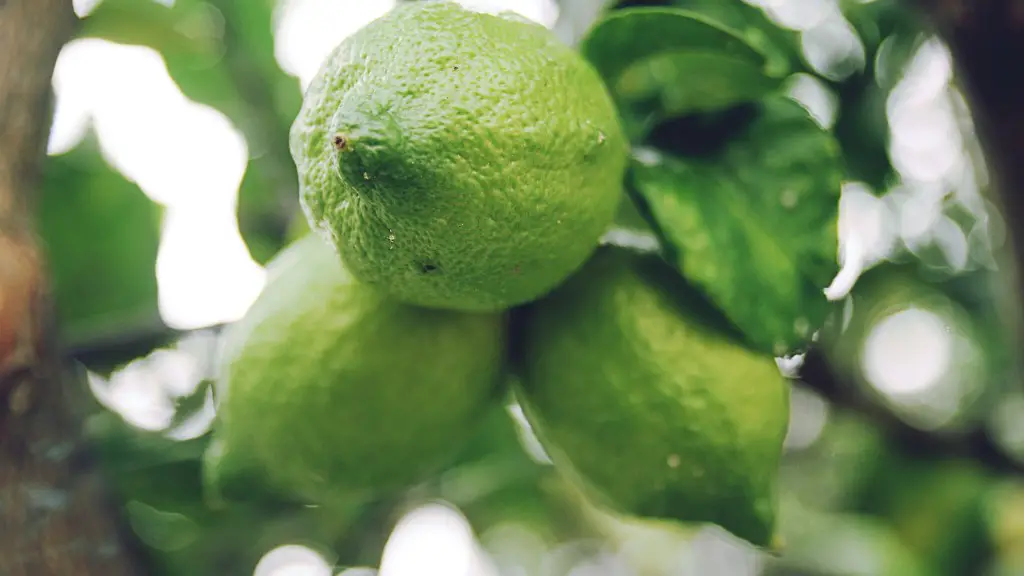A lemon tree needs adequate space to grow, and depending on its size, the pot can either be big or small. Containers, especially big ones, tend to retain more moisture and nutrients, leading to healthier and more abundant growth.
Choosing the size of pot will also depend on how and where the lemon tree is going to be planted. If it needs to be moved around, then a smaller pot is preferable, as it is easier to carry. However, a large pot may be more ideal for a permanently installed tree.
It is important to remember that a larger pot does not necessarily mean bigger or healthier tree. If the pot size is too large, it can hold extra moisture, which could potentially lead to root rot and put the lemon tree in danger.
The ideal pot size for a lemon tree is between 8-15 inches in diameter. A pot larger than 15 inches is not necessary, as it can impede the tree’s growth.
The lemon tree’s growth rate should be considered when deciding the pot size. For example, if the lemon tree is expected to exceed in size, then it may be wise to go with a bigger pot.
Whether a large or small pot is chosen, it is important to make sure to use the right soil. The soil should be well-drained, fertile, and nutrient-rich. A potting mix is usually recommended, as it allows the lemon tree to thrive and flourish.
When deciding how big a pot should be for a lemon tree, it is important to consider the growth rate of the tree, the type of soil that is used, and the purpose of the tree. With good care, the lemon tree can thrive in its new environment, regardless of the pot size.
Potting Mix
When choosing a pot for a lemon tree, it is important to ensure that the soil is the proper potting mix to ensure that the tree can grow healthy and flourish. First and foremost, the potting mix must be well-drained. If it is too moist, it can encourage root rot and can put the tree in danger.
Aside from being well-drained, the potting mix should also be nutrient-rich. A good potting mix should have a balance of organic matter and minerals. The organic matter may include peat moss, compost, and humus, while the mineral component may include sand, perlite, and vermiculite. This balanced mix will help to ensure that the lemon tree is supplied with the essential nutrients needed for growth.
Organic fertilizer is also important for a healthy lemon tree. When it comes to fertilizers, it is important to use one that is formulated specifically for citrus trees. It is not recommended to use a fertilizer that is designed for other plants, as it may be too strong and can cause damage to the tree.
It is also important to remember to water regularly. This will help to ensure that the tree is getting enough water and nutrients to stay healthy. Depending on the type of container and soil, the frequency of watering will vary. However, it is better to err on the side of caution and water more often than not.
When applying fertilizer and watering the lemon tree, make sure not to overdo it. If a tree is overwatered or over-fertilized, it can cause damage to the roots and cause the tree to suffer from nutrient deficiencies.
Sizing Up
When it comes to choosing the right size for a pot for a lemon tree, it is important to consider the size of the tree. Generally, the larger the tree, the larger the pot. An appropriate pot size will depend on the current size of the lemon tree and its expected growth rate. For example, if the tree is expected to exceed 8-15 inches, then a pot size of 15 inches or more may be recommended.
When researching pot size, it is also important to take into account the type of soil that is being used. If a soil with fine particles is being used, then a smaller pot size may be ideal. On the other hand, if a soil with larger particles is being used, then a larger pot size may be more beneficial.
The type of container is another factor that should be taken into consideration when choosing the size of a pot. If the lemon tree is to be moved around and kept in a particular space, then a smaller pot will be more suitable. However, if it is to be permanently installed, then a larger pot may be more appropriate.
When it comes to pot size and type, it is important to remember that a larger size does not necessarily mean bigger or healthier tree. If the pot is too big and can retain extra moisture, it can lead to root rot, and ultimately, put the lemon tree in danger.
No matter what size pot is chosen, it is important to make sure that the soil is the right type. A potting mix is usually recommended, as it can ensure that the lemon tree will have the essential nutrients for growth and health.
Pruning
To ensure optimal growth of a lemon tree, it is important to regularly prune the tree. Pruning plays an important role in creating shape, controlling size, and encouraging fruit production.
When pruning, it is important to maintain a balance between encouraging new growth and removing dead wood. The lemon tree should be cut and thinned, so that there is an optimal ratio of leaves and fruit. This ratio will depend on the size of the container, as well as the type of container and soil.
When pruning a lemon tree, it is important to use sharp tools to ensure a clean cut. If the tools are dull, it may cause additional damage to the tree, which can then lead to disease and other problems. It is also important to remember to avoid cutting too much of the tree, as it can cause stress and may slow the tree’s growth rate.
Aside from maintaining a balance between new growth and dead wood, pruning is also necessary to remove any dead or damaged branches. This will help to ensure that the tree is healthy, and will also allow room for new growth.
Pruning can also help to increase airflow within the container. This will help to decrease the likelihood of disease, as stagnant air can cause bacteria and fungus to develop.
When pruning a lemon tree, it is important to exercise caution. If the tree is pruned too much, it can cause significant damage to the tree and will slow its growth. Therefore, it is important to make sure to only prune healthy branches and to not cut more than one-third of the tree’s branches.
Repotting
Repotting is necessary when the tree has outgrown its current container. If a lemon tree grows too big for its pot, it can lead to root rot or other damage to the tree.
Before repotting a lemon tree, it is important to choose the right size and type of container. If the tree is expected to grow larger, then selecting a pot that is slightly bigger than its current size is recommended. It is also important to make sure that the container is the right type and material, as some materials may be more suitable than others.
Aside from choosing the right size and type of container, it is equally important to make sure the soil is the right potting mix. When choosing the soil, it is important to make sure that it is well-drained, nutrient-rich, and able to hold moisture.
Repotting can be a stressful experience for the tree, so it is important to exercise patience and caution. The tree should be repotted slowly and carefully, and it may take up to a few days to fully adjust to its new environment.
It is also important to remember to water the tree regularly in order to help the roots establish themselves in the soil. Contrary to popular belief, the tree does not need to be completely submerged in water when repotting.
After repotting, it is important to monitor the tree and check for any signs of stress or damage. If the tree looks unhealthy, it may be necessary to take action to save the tree.
Light Requirements
When planting a lemon tree in a pot, it is important to make sure that it receives adequate light. Like any other plant, a lemon tree requires light to survive and thrive.
When it comes to light, there are two types: direct and indirect. Direct light, also known as full sun, is ideal for lemon trees, as it will allow them to absorb the most amount of light. However, direct light tends to dry up the soil quickly, so it is important to water regularly.
Indirect light is also beneficial for lemon trees. This type of light is not as intense, but still allows the tree to absorb enough light for growth.
It is important to remember that the location of the pot will determine how much light it receives. If the lemon tree is planted in a shady spot, then it may not be able to absorb enough light for optimal growth.
When planting a lemon tree in a pot, it is important to ensure that it is exposed to at least 8 hours of light. If there is not enough natural light, then a supplemental light source may be necessary.
When choosing a supplemental light source, it is important to make sure that it is the right type of light. Usually, LED lighting is best, as it can produce the right amount and type of light that the lemon tree needs.
Light is an essential component for health, and it is important to make sure that the lemon tree has enough of it. When planting and caring for a lemon tree in a pot, it is important to make sure that it is receiving the right amount of light for optimal growth.



